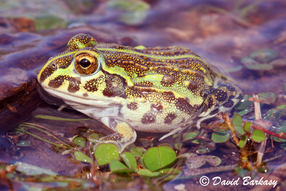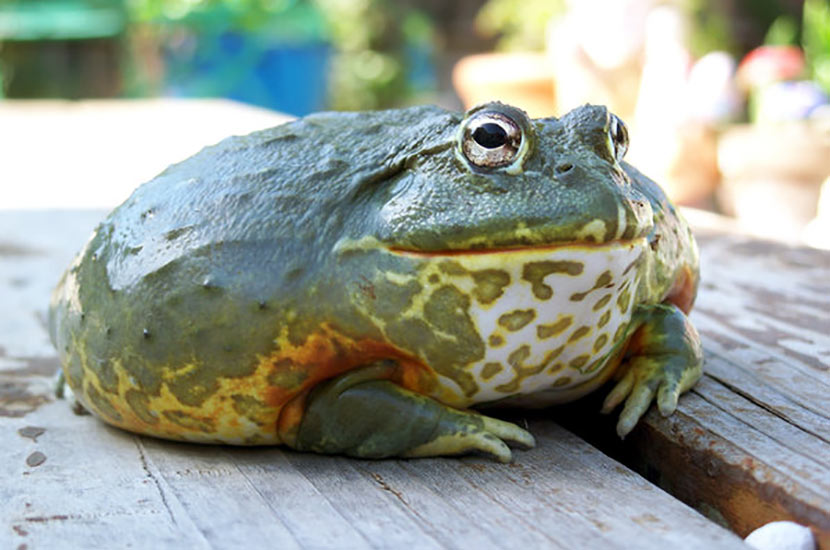Erica Mede, CVT
Natural History
 African Giant bullfrogs, also called “pixies” or “pixies”, are found throughout southern Africa in sub-Saharan regions. These areas are extremely dry most of the year which forces the frogs to aestivate in order to conserve water. Pyxies tend to live in areas that during the rainy season flood and retain water.
African Giant bullfrogs, also called “pixies” or “pixies”, are found throughout southern Africa in sub-Saharan regions. These areas are extremely dry most of the year which forces the frogs to aestivate in order to conserve water. Pyxies tend to live in areas that during the rainy season flood and retain water.
Description
This is the world’s second largest species of frog with males reaching up to10 inches in length! Females generally reach 3.5-5.5 inches long while males range from 6-10 inches long. Pyxies generally live 15-25 years with proper care and males have been known to way up to two pounds. Powerful limbs and large skulls make these frogs appear thick and stocky. Both genders have teeth like projections called odontoids in their mouth which help them capture prey as they are ambush predators.
Colors range from olive green to dark green with a pale to cream underbelly. Where the limbs meet the body there is a bright orange coloration. Many of these frogs will also have a yellow color along the sides of the body. Pyxies have large broad ridges down their backs as well.
Feeding
African bullfrogs have a strong sense of sight and will eat anything that fits in their mouths. Captive adults are frequently fed earth worms, crickets, super worms, roaches, and mice (feed sparingly). In the wild, these animals are known to eat other amphibians and small reptiles. Bullfrogs are prone to obesity especially those fed large amounts of rodents. It is recommended to feed rodents to Pyxies only once every 2 or 3 weeks. Pyxies under three inches long should be fed daily what they will consume in 15 minutes. Sub-adults and adults should be fed 2-3 times a week in the same manner. Some owners advocate the use of trout and salmon pellets in place of live prey and have success.
It is not recommended to feed bullfrogs from your hand as they have a powerful, painful bite. Placing the food in a dish or on a flat rock is a better option. Feeding with forceps is a very popular method as well. Calcium supplementation should be added to the food weekly and a multivitamin supplement every 2 weeks.
Enclosures
These frogs should always be housed alone due to their tendency towards cannibalism. A 15 gallon aquarium or equivalent sized container such as a Sterilite or Rubbermaid bin is generally acceptable for both genders. Large males can sometimes require a minimum of 20 gallon aquarium whereas smaller juvenile males and adult females can be kept comfortably in a 10 gallon aquarium. Many keepers find that using non-conventional enclosure such as plastic storage boxes is not only easier to maneuver in their homes but also less stressful for the animal due to the opaque nature of the sides. Juveniles under 3 inches can easily be maintained in a 5 gallon aquarium.
Substrate
Paper towel is by far the easiest to clean and cheapest substrate to use. However, it must be changed daily and doesn’t offer any aesthetics. Top soil it a common substrate providing a naturalistic look to the enclosure as well as offering the frog a chance to burrow under leaving only their eyes exposed in some cases. Soil must be spot cleaned daily and completely changed out every 2 weeks to prevent bacteria and fungus build-up. Moistened terry cloth towels are also utilized for substrate since they can be easily changed out. However, a few back ups will be needed and the towels must be washed and dried WITHOUT fabric softener preferably. The substrate needs to be moistened at all times with dechlorinated water. Tap water that has been dechlorinated chemically or “aged” is perfectly fine. Avoid distilled water due to the lack of minerals in the water.
Temperature
 Pyxie frogs can be easily maintained in 77-82°F ambient temperatures. At night, the temperature can drop as low as 68°F. Heating the enclosure is easily achieved using under tank heaters either under the tank or mounted on the side of the tank. Heat cable, heat tape, and other methods of heating can be utilized as well. Basking lights are contraindicated. The temperature should be maintained with the use of a thermostat and monitored with a thermometer at the level of the substrate. Moss is an excellent way to keep frogs moist but care must be taken that it is changed frequently and is in a place where the frog will not accidentally ingest it attempting to eat.
Pyxie frogs can be easily maintained in 77-82°F ambient temperatures. At night, the temperature can drop as low as 68°F. Heating the enclosure is easily achieved using under tank heaters either under the tank or mounted on the side of the tank. Heat cable, heat tape, and other methods of heating can be utilized as well. Basking lights are contraindicated. The temperature should be maintained with the use of a thermostat and monitored with a thermometer at the level of the substrate. Moss is an excellent way to keep frogs moist but care must be taken that it is changed frequently and is in a place where the frog will not accidentally ingest it attempting to eat.
Humidity
Humidity is extremely important to the health of African bullfrogs. The humidity in the enclosure should be maintained around 80-90%. This is easily checked with a hygrometer and maintained with a hydrostat. Frequent misting, moistening of the substrate, large water bowls, and foggers can all be used to maintain higher levels of humidity.
Lighting
African bullfrogs do not have many lighting requirements. They require a light cycle of 10 hours of light and 14 of darkness. An ultraviolet (UVB) light such as a ReptiGlo or a ReptiSun 5.0 can be utilized and is recommended.
Enrichment
Water bowls should be deep enough for the frog to submerge itself if desired. Water should be changed at least daily and only clean, dechlorinated water should be used. A hide box created from things as simple as a half a plastic flower pot should be offered to provide a secure place for the frog. Live plants can be easily uprooted by these powerful diggers and should be potted separately if placed in the enclosure. Fake foliage such as silk leaves can be used without problems and pose the benefit of being easily cleaned.
Sources and Suggested Reading
- The Horned Frog Family and the African Bullfrogs, Richard Bartlett, Patricia Bartlett
- Horned Frogs, Ray Hunziker, Raymond E. Hunziker, R. Hunziker
- Quick & Easy Horned Frog Caren, Allen R. Both
If you have any questions, please feel free to call us at (502) 241-4117.

